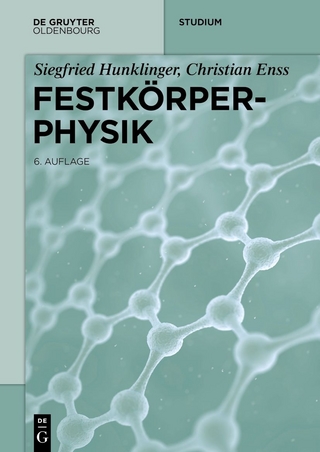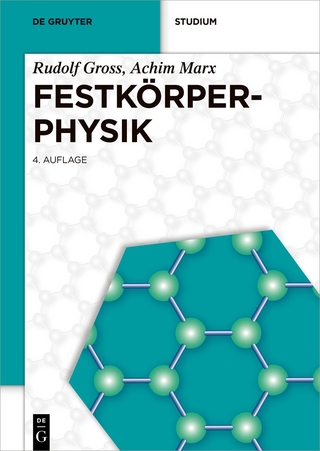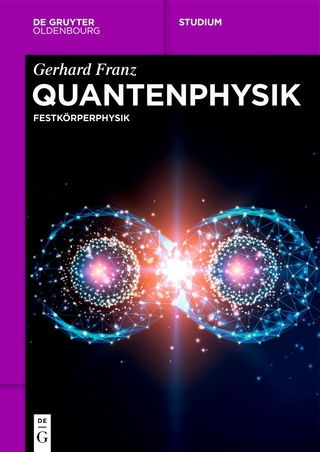
Metal-Semiconductor Schottky Barrier Junctions and Their Applications
Kluwer Academic / Plenum Publishers (Verlag)
978-0-306-41521-0 (ISBN)
- Titel ist leider vergriffen;
keine Neuauflage - Artikel merken
1. Physics of Schottky Barrier Junctions.- 1. Introduction.- 2. Origins of Barrier Height.- 2.1. Schottky-Mott Theory of Ideal Metal-Semiconductor Contact.- 2.2. Modifications to Schottky Theory.- 2.3. Classifications of Metal-Semiconductor Interfaces.- 2.4. Contacts on Reactive Interfaces.- 2.5. Contacts with Surface States and an Insulating Interfacial Layer.- 2.6. Contacts on Vacuum Cleaved Surfaces.- 3. Measurement of Barrier Height.- 3.1. Capacitance-Voltage Measurement.- 3.2. Current-Voltage Measurement.- 3.3. Photoelectric Measurement.- 4. Results of Barrier Height Measurements.- 4.1. Chemically Prepared Surfaces.- 4.2. Vacuum Cleaved Surfaces.- 4.3. Concluding Remarks.- 5. Capacitance-Voltage Characteristics.- 5.1. Electric Field and Potential Distribution in the Depletion Region.- 5.2. Depletion Region Capacitance.- 5.2.1. Ideal Schottky Barrier.- 5.2.2. Effect of Minority Carriers.- 5.2.3. Effect of Interfacial Layer.- 5.2.4. Effect of Deep Traps.- 6. Current-Voltage Characteristics.- 6.1. Transport Mechanisms.- 6.1.1. Diffusion and Thermionic Emission over the Barrier.- 6.1.2. Tunneling through the Barrier.- 6.1.3. Carrier Generation and Recombination in the Junction Depletion Region.- 6.1.4. Minority Carrier Injection.- 6.2. Forward Characteristics.- 6.3. Reverse Characteristics.- 7. Transient Behavior.- 8. Low-Resistance Schottky Barrier Contacts.- References.- 2. Interface Chemistry and Structure of Schottky Barrier Formation.- 1. Introduction.- 2. Perspectives on Schottky Barrier Formation.- 2.1. Introduction.- 2.2. Brief Review of Phenomenological Schottky Barrier Data.- 3. The Chemistry and Structure of the Interfacial Layer.- 3.1. Synopsis of the Layer-by-Layer Evolution.- 3.2. Some Techniques for Studying the Stages of Interface Formation.- 4. Evolution of the Interfacial Layer.- 4.1. Stage 0: The Clean Semiconductor Surface.- 4.1.1. Silicon (100) and (111) Surfaces.- 4.1.2. GaAs (110) and GaAs (100) Surfaces.- 4.2. Stage 1: The Dilute Limit (< 1/2 Monolayer).- 4.3. Stage 2: Monolayer Formation-Metal Film Nucleation.- 4.4. Stage 3: Additional Monolayers and Interdiffusion.- 4.5. Some Specific Characteristics of the Interfacial Layers.- 5. Formation of Interface States.- 5.1. Intrinsic Interface States Derived from the Metal and Semiconductor.- 5.2. Localized Defect and Impurity Related States.- 5.3. Interface States and the Stages of Interface Formation.- 6. Case Studies of the Chemistry and Structure of Schottky Barrier Formation.- 6.1. Case Studies of Silicon Schottky Barriers.- 6.1.1. Al, Ag, Cu, and Au Schottky Barriers.- 6.1.2. Silicide-Silicon Interfaces.- 6.2. Case Studies of III-V and II-VI Compound Semiconductor Schottky Barriers.- 6.2.1. The Ga-Al-As System.- 6.2.2. The GaAlAs Ternary System with Au Schottky Barriers.- 6.2.3. InP.- 6.2.4. Some II-VI Examples.- 7. Summary.- References.- 3. Fabrication and Characterization of Metal-Semiconductor Schottky Barrier Junctions.- 1. Introduction.- 2. Selection of Semiconductor Materials.- 3. Metal-Semiconductor Systems.- 3.1. Metal-Silicon Systems.- 3.2. Metal-GaAs Systems.- 3.3. Multilayer Metallization Systems.- 4. Design Considerations.- 5. Fabrication Technology.- 5.1. Surface Processing.- 5.2. Dielectric Film Deposition.- 5.3. Ohmic Contact Formation.- 5.4. Metal Deposition.- 5.5. Other Steps.- 6. Characterization.- References.- 4. Schottky-Barrier-Type Optoelectronic Structures.- 1. Introduction.- 2. Barrier Formation in Schottky-Barrier-Type Junctions.- 3. Transport in Schottky-Barrier-Type Structures.- 3.1. MS and MIS Structures.- 3.2. SIS Structures.- 4. Schottky-Barrier-Type Optoelectronic Structures.- 4.1. Schottky-Barrier-Type Light-Emitting Structures.- 4.2. Schottky-Barrier-Type Photodiodes.- 4.3. Schottky-Barrier-Type Photovoltaic Devices.- 4.3.1. MS and MIS Photovoltaic Devices.- 4.3.2. SIS Photovoltaic Devices.- 3. Summary.- References.- 5. Schottky Barrier Photodiodes.- 1. Introduction.- 2. General Parameters of Photodiodes.- 2.1. Signal-to-Noise Ratio (S/N).- 2.2. Noise Equivalent Power (NEP).- 2.3. Detectivity (D).- 2.4. Normalized Detectivity (D*).- 2.5. Detectivity Normalized Also with Respect to the Field of View(D**).- 2.6. Resistance Area Product.- 2.7. Response Time.- 3. Selection of Materials.- 3.1. Metal Systems.- 3.2. Semiconducting Materials.- 4. Fabrication Technology.- 5. Techniques for Evaluating Device Parameters.- 5.1. Current-Voltage Characteristics.- 5.2. Capacitance-Voltage Characteristics.- 5.3. Photoelectric Measurements.- 5.4. Electron Beam Induced Current Technique.- 6. Applications.- 7. Conclusions.- References.- 6. Microwave Schottky Barrier Diodes.- 1. Introduction.- 2. Diode Design Considerations.- 2.1. Equivalent Circuit.- 2.2. Frequency Conversion.- 2.3. Basic Mixer Diode RF Parameters.- 2.3.1. Conversion Loss Theory.- 2.3.2. Noise-Temperature Ratio.- 2.3.3. Overall Receiver Noise Figure.- 2.3.4. Mixer Noise Temperature.- 2.3.5. RF Impedance.- 2.3.6. IF Impedance.- 2.3.7. Receiver Sensitivity.- 2.3.8. Doppler Shift.- 2.3.9. Typical Doppler Radar System.- 2.4. Basic Detector RF Parameters.- 2.4.1. Video Resistance (Rv).- 2.4.2. Voltage Sensitivity.- 2.4.3. Current Sensitivity ?.- 2.4.4. Minimum Detectable Signal (MDS).- 2.4.5. Tangential Signal Sensitivity (TSS).- 2.4.6. Nominal Detectable Signal (NDS).- 2.4.7. Noise Equivalent Power (NEP).- 2.4.8. Video Bandwidth.- 2.4.9. Superheterodyne vs. Single Detection.- 2.5. Mixer Configurations.- 2.5.1. Single-Ended Mixer.- 2.5.2. Single-Balanced Mixer.- 2.5.3. Double-Balanced Mixer.- 2.5.4. Image Rejection Mixer.- 2.5.5. Image Enhanced or Image Recovery Mixer.- 3. Properties of Schottky Barrier Diodes.- 3.1. Diode Theory.- 3.2. DC Parameters.- 3.2.1. Junction Capacitance.- 3.2.2. Overlay Capacitance.- 3.2.3. Series Resistance.- 3.2.4. Figure of Merit.- 3.3. Semiconductor Materials.- 3.4. Epitaxial GaAs.- 3.5. Barrier Height Lowering.- 3.6. Fabrication.- 4. Microwave Performance.- 4.1. Mixer Diodes.- 4.2. Detector Diodes.- 5. RF Pulse and CW Burnout.- 5.1. Introduction.- 5.2. Factors Affecting RF Burnout.- 5.3. Experimental Results.- 5.4. Physical Analysis of RF Pulsed Silicon Schottky Barrier Failed Diodes.- 5.5. Physical Analysis of RF Pulsed Millimeter GaAs Schottky Barrier Failed Diodes.- 5.6. Electrostatic Failure of Silicon Schottky Barrier Diodes.- 6. Conclusions.- References.- 7. Metal-Semiconductor Field Effect Transistors.- 1. Introduction.- 2. Small-Signal FET Theory.- 3. Design Parameters of a Low-Noise Device.- 4. Practical Small-Signal FET Fabrication Techniques.- 4.1. Material Growth Techniques.- 4.2. FET Fabrication Technology.- 5. GaAs Power Field Effect Transistors.- 5.1. Principle of Power FET Operation.- 5.2. Thermal Impedance.- 5.3. Power FET Technology.- 6. Conclusions.- References.- 8. Schottky Barrier Gate Charge-Coupled Devices.- 1. Introduction.- 2. Schottky Gate CCDs.- 3. Potential-Charge Relationships.- 3.1. Surface Channel CCD.- 3.2. Bulk Channel CCD.- 3.3. Schottky Gate CCD.- 4. Charge Storage Capacity.- 4.1. Surface Channel CCD.- 4.2. Bulk Channel CCD.- 4.3. Schottky Gate CCD.- 5. Charge Transfer.- 5.1. Charge Transfer Efficiency.- 5.2. Charge Transfer Mechanisms.- 5.2.1. Surface Channel CCD.- 5.2.2. Bulk Channel CCD.- 5.2.3. Schottky Gate CCD.- 6. Input-Output Circuits.- 7. Schottky Gate Heterojunction CCDs.- 8. Experimental Results.- 8.1. High-Frequency Devices.- 8.2. Heterojunction Devices.- 9. Applications.- References.- 9. Schottky Barriers on Amorphous Si and their Applications.- 1. Introduction.- 2. Properties of Amorphous Si.- 2.1. Deposition Methods.- 2.2. Structural Properties.- 2.3. Electronic Properties.- 2.4. Surfaces.- 3. The Schottky Barrier on ?-Si:H.- 3.1. Current-Voltage Measurements.- 3.2. Capacitance Measurements.- 3.3 Internal Photoemission.- 4. Interface Kinetics and Its Effect on the Schottky Barrier.- 5. Applications.- 5.1. Drift Mobility.- 5.2. Deep Level Transient Spectroscopy.- 5.3. Solar Cells.- 5.4. Thin Film Transistors.- 6. Concluding Remarks.- References.
| Erscheint lt. Verlag | 31.5.1984 |
|---|---|
| Zusatzinfo | 38 black & white illustrations, biography |
| Verlagsort | Dordrecht |
| Sprache | englisch |
| Themenwelt | Naturwissenschaften ► Physik / Astronomie ► Festkörperphysik |
| ISBN-10 | 0-306-41521-6 / 0306415216 |
| ISBN-13 | 978-0-306-41521-0 / 9780306415210 |
| Zustand | Neuware |
| Haben Sie eine Frage zum Produkt? |
aus dem Bereich


